Related Research Articles
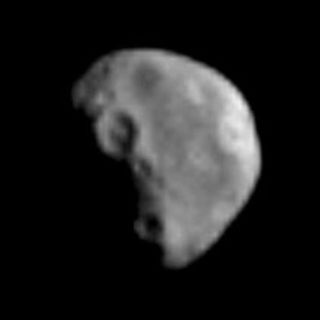
(243) Ida I Dactyl is a tiny asteroid moon that orbits asteroid 243 Ida. It was imaged by the Galileo spacecraft on August 28, 1993; Dactyl was discovered while examining the delayed image downloads from Galileo on February 17, 1994. It was provisionally designated S/1993 (243) 1. The satellite was named after the mythical creatures called dactyls who lived on Mount Ida according to Greek mythology.

A minor-planet moon is an astronomical object that orbits a minor planet as its natural satellite. As of January 2022, there are 457 minor planets known or suspected to have moons. Discoveries of minor-planet moons are important because the determination of their orbits provides estimates on the mass and density of the primary, allowing insights into their physical properties that are generally not otherwise accessible.
624 Hektor is the largest Jupiter trojan and the namesake of the Hektor family, with a highly elongated shape equivalent in volume to a sphere of approximately 225 to 250 kilometers diameter. It was discovered on 10 February 1907, by astronomer August Kopff at Heidelberg Observatory in southwest Germany, and named after the Trojan prince Hector, from Greek mythology. It has one small 12-kilometer sized satellite, Skamandrios, discovered in 2006.
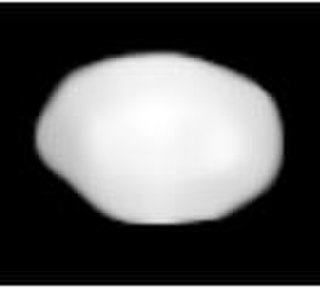
Eugenia is a large asteroid of the asteroid belt. It is famed as one of the first asteroids to be found to have a moon orbiting it. It was also the second triple asteroid to be discovered, after 87 Sylvia.
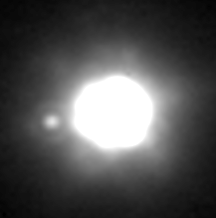
762 Pulcova is a main-belt asteroid. It was discovered by Grigoriy N. Neujmin in 1913, and is named after Pulkovo Observatory, near Saint Petersburg. Pulcova is 137 km in diameter, and is a C-type asteroid, which means that it is dark in colouring with a carbonate composition.
2578 Saint-Exupéry, provisional designation 1975 VW3, is an Eoan asteroid from the outer region of the asteroid belt, approximately 17 kilometers in diameter. It was discovered by Russian astronomer Tamara Smirnova at the Crimean Astrophysical Observatory in Nauchnyj on 2 November 1975, and named after French aviator and writer Antoine de Saint-Exupéry.
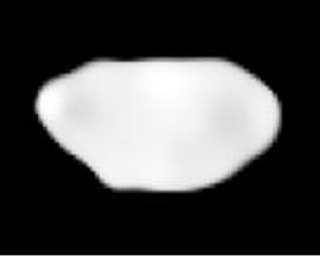
Sylvia is one of the largest asteroids. It is the parent body of the Sylvia family and member of Cybele group located beyond the main asteroid belt. Sylvia was the first asteroid known to possess more than one moon.

Camilla is one of the largest asteroids from the outermost edge of the asteroid belt, approximately 250 kilometers in diameter. It is a member of the Sylvia family and located within the Cybele group. It was discovered on 17 November 1868, by English astronomer Norman Pogson at Madras Observatory, India, and named after Camilla, Queen of the Volsci in Roman mythology. The X-type asteroid is a rare trinary asteroid with two minor-planet moons discovered in 2001 and 2016, respectively. It is elongated in shape and has a short rotation period of 4.8 hours.

Hermione is a very large binary asteroid discovered in 1872. It orbits in the Cybele group in the far outer asteroid belt. As an asteroid of the dark C spectral type, it is probably composed of carbonaceous materials. In 2002, a small moon was found to be orbiting Hermione.
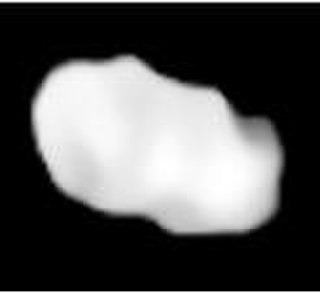
Elektra is a large outer main-belt asteroid and quadruple system with three minor-planet moons. It was discovered on 17 February 1873, by astronomer Christian Peters at Litchfield Observatory, New York, and named after Electra, an avenger in Greek mythology.

283 Emma is a large asteroid of the asteroid belt and the namesake of the Emma family. It was discovered by Auguste Charlois on 8 February 1889, in Nice, France. The reason for its name is unknown.

1998 WW31, is a non-resonant trans-Neptunian object and binary system from the Kuiper belt located in the outermost region of the Solar System, approximately 148 kilometers (92 miles) in diameter. It was first observed on 18 November 1998, by American astronomer Marc Buie and Robert Millis at the Kitt Peak National Observatory in Arizona, United States. In December 2000, a minor-planet moon, designated S/2000 (1998 WW31) 1 with a diameter of 123 kilometers (76 miles), was discovered in its orbit. After Charon in 1978, it was the first of nearly 100 satellites since discovered in the outer Solar System.
46610 Bésixdouze (French pronunciation:[be.sis.duːz]), provisional designation 1993 TQ1, is a bright background asteroid from the inner regions of the asteroid belt, approximately 2 kilometers in diameter. It was discovered on 15 October 1993, by Japanese amateur astronomers Kin Endate and Kazuro Watanabe at the Kitami Observatory in eastern Hokkaidō, Japan. The asteroid was named after "B-612", home of The Little Prince.
1313 Berna, provisional designation 1933 QG, is a background asteroid and synchronous binary system from the Eunomian region in the central asteroid belt, approximately 14 kilometers in diameter. It was discovered on 24 August 1933, by Belgian astronomer Sylvain Arend at the Uccle Observatory in Belgium. The assumed S-type asteroid has a longer-than average rotation period of 25.5 hours and is likely elongated in shape. It was named for the Swiss capital of Bern. The discovery of an 11-kilometer-sized companion was announced in February 2004.
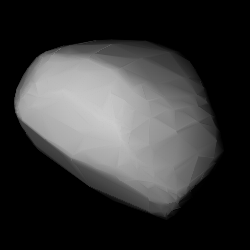
3749 Balam is a stony Flora asteroid and rare trinary system orbiting in the inner regions of asteroid belt. It also forms a secured asteroid pair with sub-kilometer sized asteroid (312497) 2009 BR60. Balam was discovered on 24 January 1982, by American astronomer Edward Bowell at Lowell's Anderson Mesa Station near Flagstaff, Arizona, and received the prov. designation 1982 BG1. It was named after Canadian astronomer David Balam. Balam measures approximately 4.1 kilometers (2.5 miles) in diameter. Its two minor-planet moons have an estimated diameter of 1.66 and 1.84 kilometers, respectively.
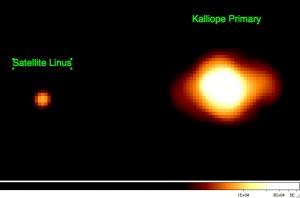
Linus, formal designation (22) Kalliope I Linus, is an asteroid moon that orbits the large M-type asteroid 22 Kalliope. It was discovered on August 29, 2001, by astronomers Jean-Luc Margot and Michael E. Brown with the Keck telescope, in Hawaii. Another team also detected the moon with the Canada-France-Hawaii Telescope on September 2, 2001. Both telescopes are on Mauna Kea. It received the provisional designation S/2001 (22) 1, until it was named. The naming proposal appeared in the discovery paper and was approved by the International Astronomical Union in July 2003. Although the naming proposal referred to the mythological Linus, son of the muse Calliope and the inventor of melody and rhythm, the name was also meant to honor Linus Torvalds, inventor of the Linux operating system kernel, and Linus van Pelt, a character in the Peanuts comic strip.

Franck Marchis, astronomer and planetary scientist, is best known for his discovery and characterization of multiple asteroids, his study of Io volcanism and imaging of exoplanets, planets around other stars.

Romulus is the outer and larger moon of the main-belt asteroid 87 Sylvia. It follows an almost-circular and close-to-equatorial orbit around the asteroid. In this respect it is similar to the other Sylvian moon Remus.

Remus is the inner and smaller moon of the main-belt asteroid 87 Sylvia. It follows an almost-circular and close-to-equatorial orbit around the parent asteroid. In this respect it is similar to the other Sylvian moon Romulus.

(523794) 2015 RR245, provisional designation 2015 RR245, is a large trans-Neptunian object of the Kuiper belt in the outermost regions of the Solar System. It was discovered on 9 September 2015, by the Outer Solar System Origins Survey at Mauna Kea Observatories on the Big island of Hawaii, in the United States. The object is in a rare 2:9 resonance with Neptune and measures approximately 600 kilometers in diameter. 2015 RR245 was suspected to have a satellite according to a study announced by Noyelles et al. in a European Planetary Science Congress meeting in 2019.
References
- ↑ IAUC 7129, announcing the discovery
- ↑ synthesis of several observations Archived 13 September 2006 at the Wayback Machine , F. Marchis.
- ↑ Assuming the same albedo as Eugenia, then using the difference in absolute magnitude
- ↑ Assuming same density and albedo as Eugenia
- ↑ W.J. Merline at al. (1999). "Discovery of a moon orbiting the asteroid 45 Eugenia". Nature. 401 (6753): 565–568. Bibcode:1999Natur.401..565M. doi:10.1038/44089. S2CID 4414973.
- ↑ "Solar System Exploration: Asteroids – Moons". National Aeronautics and Space Administration. 2011. Archived from the original on 3 August 2004. Retrieved 18 September 2011.
- 1 2 William J. Merlin; et al. (2000). "On a Permanent Name for Asteroid S/1998(45)1" (TXT). Department of Space Studies, Southwest Research Institute . Retrieved 9 November 2011.